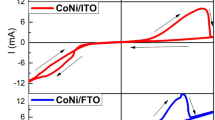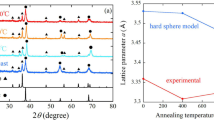Abstract
High-T c superconducting films of Y-Ba-Cu oxide were prepared on (100) MgO substrates by a chemical sol gel method. A procedure is described for preparing a superconducting film using acetate compounds dissolved in salicylic or lactic acids in the presence of ethylene glycol. This solution has superior qualities in terms of homogeneity, viscosity, and stability against atmospheric hydration. The results indicate that the nature of the solvent influences the microstructure and superconducting properties of Y-Ba-Cu-O films. X-ray diffraction analysis reveals that the annealed films are textured and had orthorhombic orientation. Transport measurements indicated that the onset temperatures of the superconductivity transition occurred between 82 and 95 K. The zero-resistance transition temperature was above the boiling point of the liquid nitrogen. The highest critical current density was 2700 A/cm2 at 20 K. It is also demonstrated experimentally that the results obtained from the X-ray diffraction analysis alone cannot provide a good criterion for evaluating the quality of a superconductor. A correlation between the crystal structure and the superconducting properties of the Y-Ba-Cu-O films is presented.
Similar content being viewed by others
References
G. C. Xiong and S. Z. Wang,Appl. Phys. Lett. 55, 902 (1989).
A. Mogro-Campero, L. G. Turner, E. L. Hall, M. F. Garbauskas, and N. Lewis,Appl. Phys. Lett.,54, 2719 (1989).
S. T. Ruggiero and D. A. Rudman, inSuperconductivity Devices (Academic Press, New York, 1990).
H. S. Kwok, J. P. Zheng, and Q. Y. Ying,Appl. Phys. Lett. 54, 2473 (1989).
T. Kumagai, H. Yokota, K. Kawaguchi, W. Kondo, and S. Mizuta,Chem. Lett. 1645 (1987).
C. E. Rice, R. B. van Dover, and G. J. Fisanick,Appl. Phys. Lett. 51, 1842 (1987).
A. H. Hamdi, J. V. Mantese, A. L. Micheli, R. C. O. Laugal, D. F. Dungan, Z. H. Zhang, and K. R. Padmanabhan,Appl. Phys. Lett. 51, 2152 (1987).
R. S. Liu, W. N. Wang, C. T. Chang, and P. T. Wu,Jpn. J. Appl. Phys. 28, L2155 (1989).
M. Sayer, A. A. Hussain, and G. Yi, U.S. Patent Application, Queen's University, Canada (1991).
S. I. Bondarenko, I. M. Dmitrenko, and E. I. Balanov,Sov. Phys. Solid State 12, 1113 (1970).
T. Y. Hsiang and D. K. Finnemore,Phys. Rev. B 22, 154 (1980).
A. A. Hussain and M. Sayer,J. Appl. Phys. 70, 1580 (1991).
V. Ambegaokar and A. Baratoff,Phys. Rev. Lett. 10, 486 (1963);11, 104(E) (1963).
P. G. deGennes,Superconductivity of Metals and Alloys (Benjamin, New York, 1966), p. 66.
Author information
Authors and Affiliations
Rights and permissions
About this article
Cite this article
Hussain, A.A., Sayer, M. Chemical fabrication of superconducting Y-Ba-Cu oxide films. J Supercond 5, 11–18 (1992). https://doi.org/10.1007/BF00617990
Received:
Issue Date:
DOI: https://doi.org/10.1007/BF00617990




